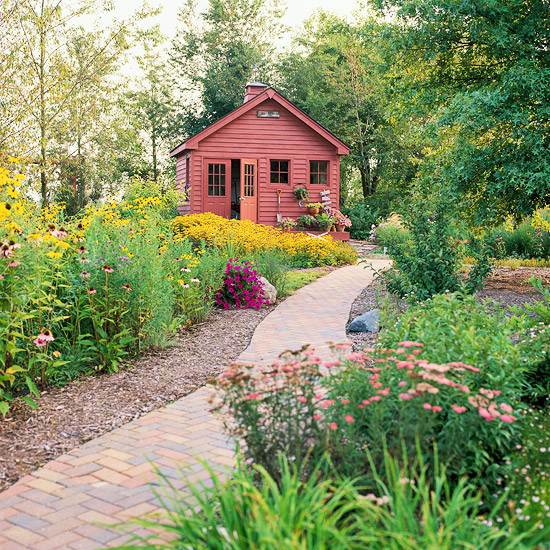Create a wildlife habitat in the garden or yard
Birdsong and sensory butterfly flutter bring sparkle to any garden. In the garden, which is presented here, were from a reckless path to the house. Wild grasses – including switchgrass and little grass beard – offers year-round beauty. Perennials such as black-haired son-Eyed Susan, New England Aster, Echinacea purpurea and Knollige milkweed offer vivid colors and nectar. Exposure
Birds, butterflies, bees and other bugs in the garden
 Birds, butterflies, bees and other bugs accumulate in the environment which is multi-level, with dense evergreen deciduous; Sublayer is represented by shrubs and vines, then get grasses and perennials to the ground. By far, the garden looks like any other densely planted out. Its nice design shines through the combination of perennials, shrubs and trees that provide comfort material and assembly throughout the year. Almost everything here is taste in a plane Rudbeckia, blue diamond, fat hen, sage, Anisminze, phlox and hydrangea are selected for potential pollinators. Native flowers and grasses grow freely among the trees and bushes
Birds, butterflies, bees and other bugs accumulate in the environment which is multi-level, with dense evergreen deciduous; Sublayer is represented by shrubs and vines, then get grasses and perennials to the ground. By far, the garden looks like any other densely planted out. Its nice design shines through the combination of perennials, shrubs and trees that provide comfort material and assembly throughout the year. Almost everything here is taste in a plane Rudbeckia, blue diamond, fat hen, sage, Anisminze, phlox and hydrangea are selected for potential pollinators. Native flowers and grasses grow freely among the trees and bushes  If flowers and native freely between the trees and bushes weeds grow here, they create an autonomous, plants environment and resident birds, butterflies, bees, amphibians and mammals support, trust and rely on them in any season. Native plants require less maintenance than species (non-native) exotic plants, as they are perfectly adapted to the soil and climate.
If flowers and native freely between the trees and bushes weeds grow here, they create an autonomous, plants environment and resident birds, butterflies, bees, amphibians and mammals support, trust and rely on them in any season. Native plants require less maintenance than species (non-native) exotic plants, as they are perfectly adapted to the soil and climate.
Garden tip: take beware the invasion of non-native as Purple loosestrife, Japanese knotweed and Polyantha Rose. Some adapt so they rampant spread of alien species and intimidation into submission. It depends on us to restore the balance of nature by removing aggressive invaders of our gardens and replace them with honest flowers. Invest time in planning and preparation  A wildflower meadow is actually once designed without care. For success, you invest time for planning and preparation. 1) buy mixtures of wildflower seeds, which contain such species that grow well in your area. Have an impact on the soil type, moisture levels and sunlight. 2) Prepare the soil before planting to kill the existing lawn. The most environmentally friendly method includes "solarization" of the soil. The soil should be soaked, then cover with clear plastic cover. Remove it after several weeks. Most experts do not recommend cutting – it brings weed seeds that lie dormant in the soil. In large areas, do not use system sowing seedlings. For smaller areas you spread seed by hand; Mix the seeds with a light material, such as sawdust or Bleichmoostorf. 3) Pour the first regular season until well gewurzel. delicate purple flowers in the garden pulling plants for bees
A wildflower meadow is actually once designed without care. For success, you invest time for planning and preparation. 1) buy mixtures of wildflower seeds, which contain such species that grow well in your area. Have an impact on the soil type, moisture levels and sunlight. 2) Prepare the soil before planting to kill the existing lawn. The most environmentally friendly method includes "solarization" of the soil. The soil should be soaked, then cover with clear plastic cover. Remove it after several weeks. Most experts do not recommend cutting – it brings weed seeds that lie dormant in the soil. In large areas, do not use system sowing seedlings. For smaller areas you spread seed by hand; Mix the seeds with a light material, such as sawdust or Bleichmoostorf. 3) Pour the first regular season until well gewurzel. delicate purple flowers in the garden pulling plants for bees  Berries planted in the garden or yard
Berries planted in the garden or yard  Planters fixed windows – elegant atmosphere
Planters fixed windows – elegant atmosphere  Insects of all kinds
Insects of all kinds  Beautiful pond full of life in the garden
Beautiful pond full of life in the garden  Wooden bird house in the garden
Wooden bird house in the garden  Fruit trees in the yard
Fruit trees in the yard  Harvesting of plants, trees and shrubs
Harvesting of plants, trees and shrubs  drink birds in the garden
drink birds in the garden  Are you certified!
Are you certified! 
















